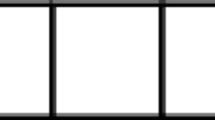Abstract
We develop the theory of copartitions, which are a generalization of partitions with connections to many classical topics in partition theory, including Rogers–Ramanujan partitions, theta functions, mock theta functions, partitions with parts separated by parity, and crank statistics. Using both analytic and combinatorial methods, we give two forms of the three-parameter generating function, and we study several special cases that demonstrate the potential broader impact the study of copartitions may have.

Similar content being viewed by others
Data Availability Statement
Data sharing is not applicable to this article as no datasets were generated or analyzed during the current study.
References
George E. Andrews, The number of smallest parts in the partitions of\(n\), J. Reine. Angew. Math. 624 (2008), 133–142.
George E. Andrews, Integer partitions with even parts below odd parts and the mock theta functions, Ann. Comb. 22 (2018), no. 3, 433–445.
George E. Andrews,Partitions with parts separated by parity, Ann. Comb. 23 (2019), no. 2, 241–248.
Hannah E. Burson and Dennis Eichhorn, On the parity of the number of \((a,b,m)\)-copartitions of \(n\). https://arxiv.org/pdf/2201.04247 (2022).
Hannah E. Burson and Dennis Eichhorn, On the positivity of infinite products connected to partitions with even parts below odd parts and copartitions. https://arxiv.org/pdf/2209.13784 (2022).
Shane Chern, On a problem of George Andrews concerning partitions with even parts below odd parts, Afr. Mat. 30 (2019), no. 5-6, 691–695.
Shane Chern, Note on partitions with even parts below odd parts, Math. Notes 110 (2021), no. 3-4, 454–457.
Frank Garvan and Michael J. Schlosser, Combinatorial interpretations of Ramanujan’s tau function, Discrete Math. 341 (2018), no. 10, 2831–2840.
Valery Gritsenko, Nils-Peter Skoruppa, and Don Zagier, Theta blocks, preprint (2019).
G. H. Hardy, Ramanujan: Twelve Lectures on Subjects Suggested by His Life and Work, The University Press, Cambridge [England], 1940.
Byungchan Kim, On the number of partitions of n into k different parts, J. Number Theory 132 (2012), no. 6, 1306–1313.
Arnold Knopfmacher and Neville Robbins, Identities for the total number of parts in partitions of integers, Util. Math. 67 (2005), 9–18.
Neil J. A. Sloane and The OEIS Foundation Inc., The On-Line Encyclopedia of Integer Sequences, http://oeis.org, 2022.
NIST Digital Library of Mathematical Functions, http://dlmf.nist.gov/, Release 1.0.19 of 2018-06-22, F. W. J. Olver, A. B. Olde Daalhuis, D. W. Lozier, B. I. Schneider, R. F. Boisvert, C. W. Clark, B. R. Miller and B. V. Saunders, eds.
L.J. Rogers, Second memoir on the expansion of certain infinite products, Proc. London Math. Soc. 25 (1894), no. 1, 318–343.
L.J. Rogers and Srinivasa Ramanujan, Proof of certain identities in combinatory analysis, Proc. Camb. Phil. Soc. 19 (1919), 211–216.
Issai Schur, Ein Beitrag zur additiven Zahlentheorie und zur Theorie der Kettenbrüche, S.-B. Preuss. Akad. Wiss. Phys.-Math. Kl. 302-321 (1917), 117–136.
Armin Straub, Core partitions into distinct parts and an analog of Euler’s theorem, Eur. J. Comb. 57 (2016), 40–49.
Acknowledgements
The authors would like to thank George Andrews for suggesting taking a deeper look at \(\mathcal{EO}\mathcal{}^*(n)\). The authors would also like to thank Frank Garvan for bringing the concept of capsids and [8] to our attention. Finally, the authors would like to thank the anonymous referees for their very thoughtful and helpful comments.
Author information
Authors and Affiliations
Corresponding author
Ethics declarations
Conflict of Interest
The authors have no relevant financial or non-financial interests to disclose.
Additional information
Communicated by Jang Soo Kim.
Publisher's Note
Springer Nature remains neutral with regard to jurisdictional claims in published maps and institutional affiliations.
Rights and permissions
Springer Nature or its licensor holds exclusive rights to this article under a publishing agreement with the author(s) or other rightsholder(s); author self-archiving of the accepted manuscript version of this article is solely governed by the terms of such publishing agreement and applicable law.
About this article
Cite this article
Burson, H.E., Eichhorn, D. Copartitions. Ann. Comb. 27, 519–537 (2023). https://doi.org/10.1007/s00026-022-00607-1
Received:
Accepted:
Published:
Issue Date:
DOI: https://doi.org/10.1007/s00026-022-00607-1




